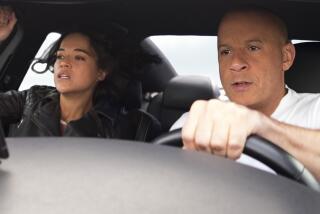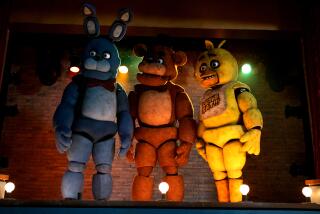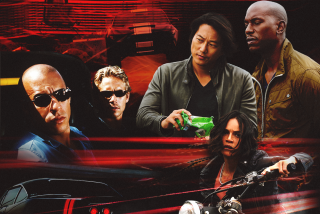Review: With ‘F9,’ the ‘Fast & Furious’ franchise mostly recovers from its days of blunder
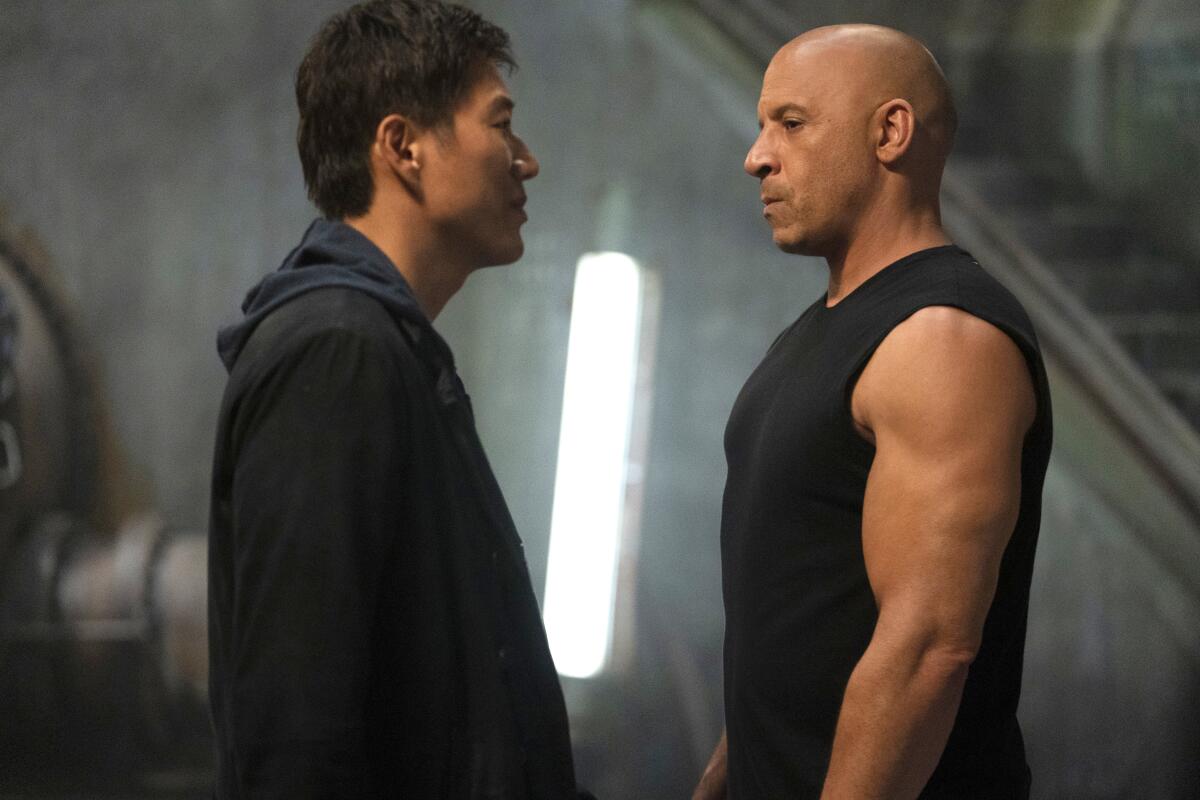
The Times is committed to reviewing theatrical film releases during the COVID-19 pandemic. Because moviegoing carries risks during this time, we remind readers to follow health and safety guidelines as outlined by the Centers for Disease Control and Prevention and local health officials.
Before a recent screening of “F9: The Fast Saga,” a theater representative welcomed us back to the movies — “us” being an audience of mostly masked journalists, scattered in semi-distanced formations before an Imax screen — and made the usual requests that we turn off our phones and avoid divulging any of the movie’s big secrets. Exactly how secret any of them can be considered at this point, more than a year after the revelation-packed first “F9” trailer dropped, is an open question. As is often the case with megabucks entertainments like this one, the major studios demand of the press a level of professional discretion that their own marketing departments have been happy to disregard.
Not that I’m really complaining. After more than a year away from theaters, it’s reassuring to return to these shared rituals of professional moviegoing, to say nothing of the time-honored if mostly surprise-free conventions of a new “Fast & Furious” flick. And what this latest chapter is selling, above all, is reassurance. From the minute the Universal logo flashes across the screen and roaring engines flood the soundtrack, a sense of blessed familiarity seizes hold. Fifteen months after the pandemic set in and “F9” was abruptly yanked from 2020 release schedules, the movie’s mere arrival signals a return to normalcy — if by normalcy you mean hot cars, strained wisecracks, gravity-defying stunts, logic-defying revisionism and a well-worn clan of renegade motorheads.
These of course include mainstays such as Michelle Rodriguez, Jordana Brewster, Chris “Ludacris” Bridges, Tyrese Gibson and Nathalie Emmanuel, bringing their various areas of expertise to bear on the tire-burning, heist-rigging plot, plus a couple of second-banana gearheads (Lucas Black and Bow Wow) whom you may recall from “The Fast and the Furious: Tokyo Drift.” But the most important player from that flavorsome 2006 movie — an attempted series reboot inelegantly reverse-shoehorned into the overarching storyline — is surely the charismatic Sung Kang, whose reappearance here as the presumed-dead Han has set off meticulously coordinated waves of fan excitement.
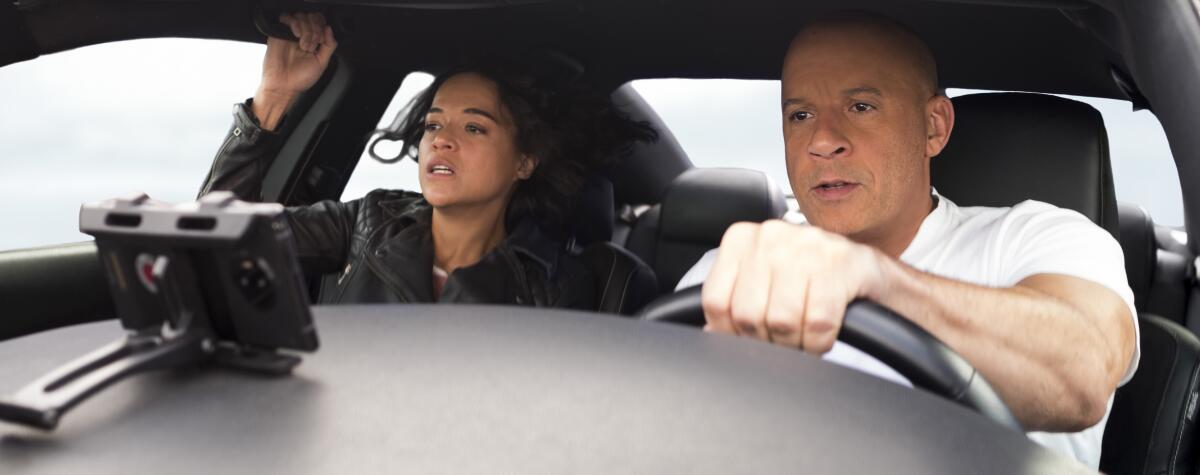
Even if the phrase #JusticeForHan means nothing to you, don’t worry about it: Just sit back, relax and enjoy the gravelly intonations of Vin Diesel as the gang’s ringleader, Dominic Toretto. Having settled down in remote seclusion with his wife, Letty (Rodriguez), and young son, Dom has become ever more reflective with age (as anyone would with a head that shiny). But when we first meet Dom in “F9,” he’s played by the younger Vinnie Bennett in an explosive race-track prologue set in 1989 Los Angeles. Within moments, Dom’s beloved father has gone off to that great big speedway in the sky — a life-altering tragedy that Dom recounted in the very first “The Fast and the Furious” movie. Apparently he left out some crucial details, like the existence of a long-estranged younger brother, Jakob, who may have been responsible for their dad’s death.
Jakob is played in flashbacks by Finn Cole and in the present day by that human colossus John Cena, and his latest scheme proves nefarious and far-reaching enough to bring Dom out of retirement. “Family,” Dom’s touching if tiresomely over-repeated mantra, thus takes on a more literal flesh-and-blood meaning. Still, for all the retconned sibling rivalry nonsense, Jakob is basically the latest iteration of a role previously filled by Dwayne Johnson and Jason Statham: the semi-redeemable antagonist brought in to raise the stakes, smash things up and keep Dom’s (and by all accounts, Diesel’s) ego in check.
Their dynamic may be familiar, but Diesel and Cena are hilariously well matched. When the Toretto brothers go at it with fists and firearms, they resemble nothing so much as warring twin sequoias: mighty, soulful and wooden. The circumstances behind their reunion — involving a downed plane, a sneering Charlize Theron, a fictional Central American republic and some items from the discount bin at MacGuffins “R” Us — are barely worth unpacking here. They serve their purpose, which is to send Dom and his pit crew on another globe-trotting mission to save humanity and the fossil-fuel industry, all while stringing together a bunch of increasingly desperate answers to the question “What else can we make a car do?”
In “F9,” directed with practiced flair and controlled chaos by the franchise veteran Justin Lin, a car can survive a spin through a live minefield, swing from a vine over an open gorge like Tarzan, hop a ride with a passing aircraft and even blast its way into [spoiler redacted]. As Lin chases his characters around Tokyo and London, pausing for a glamorous rendezvous with Helen Mirren and a too-quickly-abandoned ramen dinner with Rodriguez and Brewster, he sustains a nice balance of the awesome and the absurd. He repeatedly abuses the laws of physics (I look forward to the explainers on what “F9” gets wrong about super-powered electromagnets) without entirely demolishing the laws of cinematic coherence.
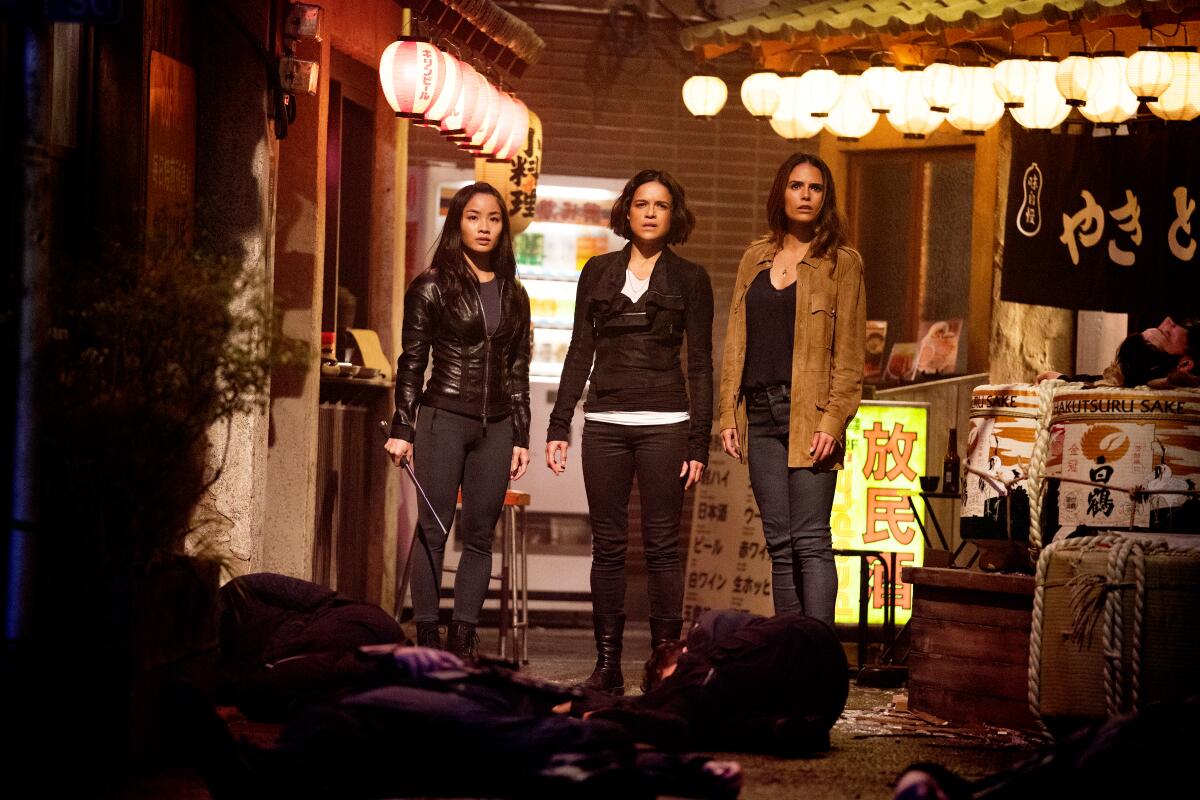
It seems almost churlish to note that Lin never quite matches the delirious highs of his “Fast Five” (2011), the capstone of the series and the picture that transformed a lucrative line of street-racing muscle-car movies into full-blown vehicular heist thrillers: less “Days of Thunder,” more days of plunder. Since then, it’s been more like days of blunder: The James Wan-directed “Furious 7” had its poignant pleasures, especially its moving salute to the late Paul Walker. But its 2017 follow-up, “The Fate of the Furious,” was a rudderless bore that upped the outlandish set pieces but abandoned some of the series’ core narrative principles.
What Lin restores in this mostly solid entry (which he co-wrote with Daniel Casey, both stepping in for longtime series screenwriter Chris Morgan) is a sense of emotional continuity. In returning to the foundations of “Tokyo Drift” and bringing Han back into the picture (with an explanation no more tortured or implausible than, say, a car flying between skyscrapers), he resurrects one of his more intriguing creations and brings his history with Kang full circle in ways that hark back to their first feature collaboration, “Better Luck Tomorrow” (2002). He also reaffirms the “Fast & Furious” franchise as one of Hollywood’s most lucrative serialized soap operas, one that tries to keep and renew faith with the audience by returning, again and again, to its own convoluted narrative history.
Like the most durable soaps — though with more tattoos, Coronas and broken glass — these movies inhabit a fantasy world where bitter grudges can be resolved within minutes, multiracial harmony is no big deal and the dead rarely stay dead for too long. All of which is reassuring, as noted earlier, in ways that are scarcely lost on “F9” itself: The characters even maintain a running commentary on whether, given all their death-defying antics, they might be trapped in some kind of elaborate simulation. It’s a slyly self-conscious touch that suggests that, after two decades, nine films, a spinoff and nearly $6 billion in global spoils, even the “Fast & Furious” movies may finally be reaching the limits of their ability to bend metal, time and reality indefinitely. Stay tuned.
‘F9: The Fast Saga’
Rated: PG-13, for sequences of violence and action, and language
Running time: 2 hours, 25 minutes
Playing: In general release
More to Read
Only good movies
Get the Indie Focus newsletter, Mark Olsen's weekly guide to the world of cinema.
You may occasionally receive promotional content from the Los Angeles Times.
